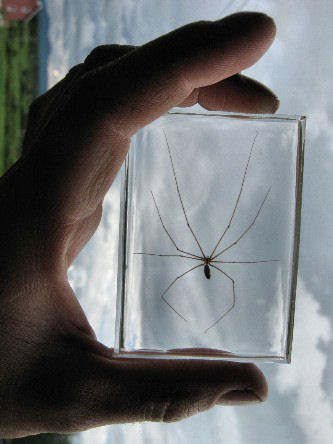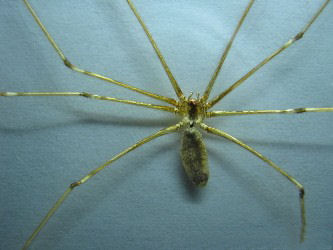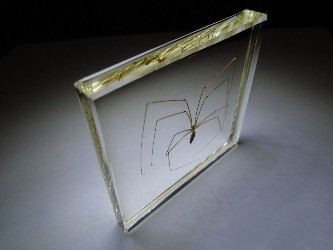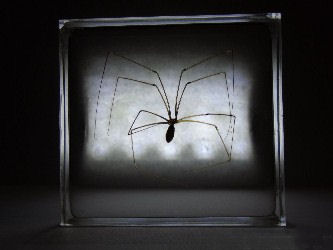








PHOLCUS PHALANGOIDES SPIDER TAXIDERMY
|
 |
 |
 |
 |
 |
 |
 |
 |
 |
|
Spider Identification Guide(PDF)
CLICK FOR DOWNLOAD (PDF) ---------------------------------
KINGDOM : Animalia
PHYLUM : Arthropoda
CLASS : Arachnida
ORDER : Araneae
SUBORDER : Araneomorphae
FAMILY : Pholcidae
GENUS : Pholcus
SPECIES : Pholcus phalangioides
--------------------------------- Spiders around the home & yard (PDF) CLICK FOR DOWNLOAD (PDF) |
PHOLCUS PHALANGOIDES SPIDER
Pholcus phalangioides, known as the cellar spider or the skull spider due to its cephalothorax looking like a human skull, is a spider of the family Pholcidae.
Females have a body length of about 9 mm; males are slightly smaller. Its legs are about 5 or 6 times the length of its body (reaching up to 7 cm of leg span
in females). Its habit of living on the ceilings of rooms, caves, garages or cellars gives rise to one of its common names. They are considered beneficial in
some parts of the world because they kill and eat other spiders, including species that can be considered a problem to humans such as hobo and redback
spiders.
Pholcus phalangiodes can be found in undisturbed, low light locations. Some places one might encounter this spider are in basements, under stones, under
ledges, and in caves. People most often associate these spiders with living on ceilings and in corners in homes. They make their webs large, loose, and flat,
but they can make them in irregular shapes to fit into surrounding objects. Their webs are normally oriented horizontally. Pholcus phalangioides hangs
upside down on the web it makes.
This is the only spider species described by the Swiss entomologist Johann Kaspar Füssli who first recorded it for science in 1775. Confusion often arises over
its common name, because "daddy long-legs" is also applied to two other distantly related arthropods: firstly another arachnid from order Opiliones
otherwise known as the harvestman, and an insect less ambiguously called the crane fly.
Originally a species restricted to warmer parts of the west Palearctic, through the help of humans this synanthrope now occurs throughout a large part of the
world. It is unable to survive in cold weather, and consequently it is restricted to (heated) houses in some parts of its range.
Pholcus phalangioides is not considered aggressive, its first line of defense being to shake its web violently when disturbed as a mechanism against predators.
It can easily catch and eat other spiders (even those much larger than itself, such as Eratigena atrica), mosquitoes and other insects, and woodlice.
When food is scarce, it will prey on its own kind. Rough handling will cause some of its legs to become detached.
Because they originally came from the subtropics, these spiders do not appear to be influenced by seasonal changes and breed at any time of the year. The
female holds the 20 to 30 eggs in her pedipalps. Spiderlings are transparent with short legs and change their skin about 5 or 6 times as they mature.
Because of the translucent quality of this animal, using a microscope it is possible to see the moving blood cells in the legs and body of a living animal.es are small to medium-sized, i.e. the size of their bodies varies from 1 to 18 millimeters. The bodies of most
of their specimens are arched and egg-shaped, and they often possess a metallic luster or multiple colors. The head's shape (disregarding
antennae and mouthparts) is roundish. In most specimens the antennae are notably shorter than head, thorax and abdomen, i.e. not more
than half their combined length. The second antennae segment is of normal size (which differentiates leaf beatles from the closely
related longhorn beetles). The antennae's segments are of a more or less equal shape, at most they gradually widen towards the tip.
The first segment of the antennae, however, in most cases is larger than the following ones. Like the head, the eyes in most cases are also
of a round shape. The pronotum of leaf beatles is arched in different shapes; only rarely it protrudes in bumpy shapes. The first three
sternites are not fused; there are sutures. All leaf beetles possess wings. Only in some cases they are shortened, and they never leave
more than the last tergum uncovered.
|